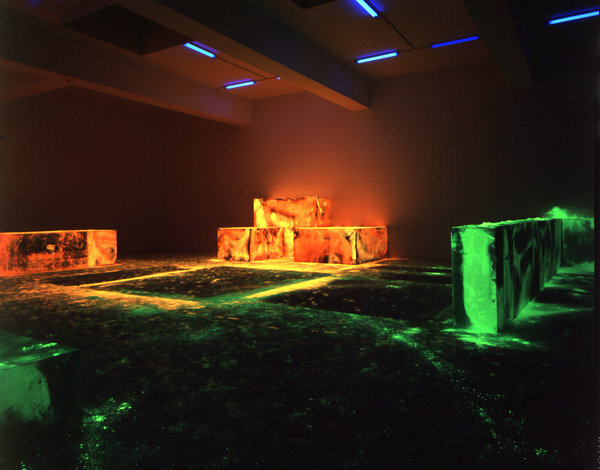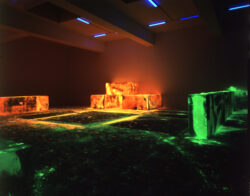Keith Sonnier
In the 1990s, the Mamou-born New York sculptor Keith Sonnier was among a handful of young artists in the so-called Process Art movement who used the detritus of modern society to create artworks that focused more on materials and process than finished object.

Courtesy of Keith Sonnier.
Color reproduction of a photograph of Keith Sonnier's neon installation entitled, “Fluorescent Room.”
In the 1960s, the Louisiana-born New York sculptor Keith Sonnier was among a handful of young artists in the process art movement, who used the detritus of modern society to create artworks that focused more on materials and process than finished object. He was also among the earliest artists to use neon light as a central element in his work. Sonnier has used various metals, machinery, plastic, bamboo, wood, and found objects to create sculpture that explores his interest in the environment, anthropology, architecture, and his Cajun roots in South Louisiana. “It’s work about modern culture — dissection and an attempt at explanation and acculturation,” he said.
Born on July 31, 1941, in Mamou, Louisiana, Sonnier is at his best when mining imagery associated Cajun culture. He responded to the 2010 BP oil spill in the Gulf of Mexico with a special exhibition of his work, titled Fort Crèvecouer (Fort Broken Heart) at the Louisiana Arts and Science Museum in Baton Rouge. The exhibit included a dozen objects from earlier series created between 1981 and 2000. The series Explorer (1981), Tidewater (1994), Cat Doucet (1996) and Abri (2000)—a Cajun word for the deer hunting stands pervasive in rural Louisiana—have obvious connections to Acadian culture and history. Sonnier’s Brazil series was inspired by voodoo and Brazil’s Carnival. Works such as Ouachita, in the Fort Crèvecouer exhibition, respond to the traditions of Acadiana. Quachita’s free-flowing and sensuous lines of radiant light create the illusion of a woman dancing in a halo of neon to pulsating music in a roadside Cajun dance hall.
Sonnier readily acknowledges the influence of his early childhood on his work. Growing up in Mamou in the 1940s and 1950s was “wonderful, considering I was oblivious to everything else,” he said. Sonnier became interested in art when he was stricken with meningitis at the age of fifteen. “I stepped back and really observed life. I studied art when I was ill. I didn’t know what an artist was, but I knew I wanted a career in the arts.” His parents, who operated a hardware store in Mamou, were supportive. From 1959 to 1963, he studied art at the University of Southwestern Louisiana (USL, now the University of Louisiana at Lafayette) under Calvin Harlan. After USL, Sonnier spent a year traveling and studying in France, where his Cajun French came in handy. Returning home, he went on to receive a master of fine arts degree in 1966 from Douglas College at Rutgers University in New Brunswick, New Jersey. While at Rutgers, Sonnier got involved in the New York art scene. “It was the first time I was really exposed to the avant-garde,” he said. “I’d seen all the European paintings, but I’d never really met a living, working artist, and that’s what changed my attitude so much when I was in the East.”
Sonnier has participated in scores of solo and group shows in many of the world’s best known museums, including the Museum of Modern Art and the Whitney Museum of American Art in New York City; the Los Angeles Museum of Art in California; the Kaiser Wilhelm Museum in Cologne, Germany; the Hara Museum in Tokyo, Japan; the Musée National d’Art Moderne in Paris, France; the Venice Biennial in Italy; and the New Orleans Museum of Art. His work can be found in more than thirty museums across Europe, North America, Australia, Israel, and Japan. A selected list includes the Chrysler Museum in Norfolk, Virginia; the Musée National d’Art Moderne, Centre Georges Pompidou, in Paris, France; the Museum Haus Lange in Krefeld, Germany; Halle Sud in Geneva, Switzerland; Kunsthalle Nurnberg in Nuremburg, Germany; Kunstverein St. Gallen in Gallen, Switzerland; the Stedelijik Museum in Amsterdam, the Netherlands; the Kaiser Wilhem Museum in Krefeld, Germany; the Staedtisches Museum Abteiber in Monchengladbach Germany; the Miami Art Museum in Florida; the Heckscher Museum of Art and PS 122, both in New York City; the Kemper Museum of Contemporary Art in Kansas City, Missouri; the Museum Moderner Kunst Siftung Ludwig in Vienna, Austria; the Musée d’Art Contemporani de Barcelona in Spain; the Musée Saint Pierre in Quebec, Canada; and the National Gallery of Art in Canberra, Australia.
Sonnier’s awards include a John Simon Guggenheim Memorial Fellowship in 1974; first prize at the Ninth International Biennial Exhibition of Prints at National Museum of Modern Art in Tokyo in 1974; and National Endowment for the Arts grants in 1975 and 1981.
